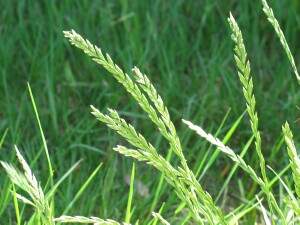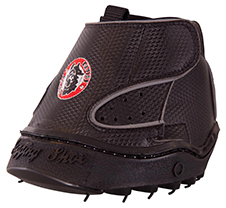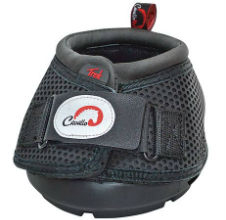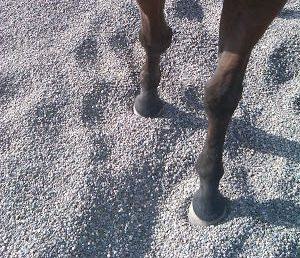I've heard about this transition period...
What does it mean for my horse and me?

Some horses have their shoes removed and are fine without them.
Others need a bit more care, to restore weak feet back to soundness.
The Transition Period
Becoming barefoot is sometimes not as simple as removing the shoes. Preparing yourself and your horse for success before you take the shoes off maximises results with minimal disruption.
The "transition period" refers to the time taken to restore the horse to a period of soundness following the removal of shoes. This can take a few days, weeks, or even months, depending on the current health of the feet.
If the horse has been shod for some time, it may have been affected by common side effects of shoeing. The severity of these issues can contribute to a longer transition time. In these cases, you may need to rest the horse from its current activities, to allow the foot to regain strength and recover to a more natural shape.
However, there are things you can do before you remove the shoes that make the transition time as short as possible.
Address the Diet
Inappropriate diet is one of the biggest contributors to low levels of inflammation in the foot, and subsequently poor performance.
This may not be noticed when shod, leading to the idea that the current diet is good for them. But a barefooted horse is much more obvious in its display of low-levels of lameness. You may not have realised that your bucket feed or rich grazing may have been contributing to poor hoof health, but you may when unshod.
Addressing the diet a few weeks before the shoes are removed is a successful way of making sure any nutritional-related problems are minimised.


Be Prepared to Buy Boots (If Needed)
Assuming the foot is healthy enough for exercise, hoof boots will increase the usability of the foot in the same way a shoe does. However, these are removable, so are only added to the feet when protection is needed, and when fitted with therapeutic pads, actively increase the strength of the foot.
At first they may seem fiddly, but the newer ones are very easy to take on and off, sometimes with just a single velcro strap to secure the boot. I like to view them as a piece of tack that you put on / take off your horse as you do with other tack when preparing to ride.
In cases of weak feet or poor performance without shoes, they will be fundamental to the recovery of the internal structures of the foot. The unhealthier the feet are, the more likely they are to need boots during the transition period.
Note: If you have just taken the shoes off and your horse is sore, boots will immediately provide comfort, but the feet may still be too inflamed or weak for exercise. Your hoofcare professional will advise you on the level of activity you can expect during this period.



Hoof boots provide protection only when needed. When fitted with therapeutic pads, they can actively make the foot healthier.
Encourage Movement in a Supportive Environment
Allow the foot as much movement as possible. If you stable your horse, consider 24/7 turn-out. A horse stabled for 12hrs a day essentially does half of the daily exercise (and therefore covers half of the distance) an unstabled horse does. The more a horse moves, the quicker the hoof grows. Movement stimulates growth. And using the environment to your advantage can accelerate this process by doing a lot of work for you.
Surfaces that support the entire weight of the foot are called conformable surfaces - they mould to the underside of the shape of the horses foot. Conformable surfaces can be very useful in creating a healthy foot, or recovering an unhealthy foot, as they engage and develop all of the weight-bearing structures. Sand and deep pea gravel are excellent examples of this kind of surface, and daily usage of these surfaces will improve foot health.
Throwing some rubble in front of the water trough may not always be helpful. Non-conformable surfaces require feet of a certain level of health for the horse to be comfortable on. This may not "toughen up the feet" but may instead overload the foot, resulting in bruising and abscessing.
Some horses may have such weak feet that they are sore on tarmac or smooth concrete. If part of your daily routine involves walking across these surfaces, you may need some form of protection to cushion the foot until it is strong enough.
You may need a regime of specific activity, such as in-hand walking on a specific surface, or long-lining with boots and pads on. The health of the feet will dictate what level of performance you start from.


Expect the Foot To Change
Appearance does not equate to soundness. A foot that looks normal may be internally very weak.
The foot may change shape when it is no longer constricted by a shoe into a specific shape. This is perfectly normal. Horse physiology is connected to the way they move, so a change in the way the foot is used also changes the musculature of the body.
Forget Hoof Oils/Hardeners/Moisturisers
The hoof has developed it's own moisture control system over many thousands of years in all climates. Moisture moves in one direction - from the inner of the hoof to the outer. Often, thin cracks that give the impression the hoof is too dry are signs that the outer wall is too wet!
The majority of topical hoof products contain a lot of chemical ingredients that are detrimental to hoof health. Hardeners, for instance, contain formaldehyde (used for embalming). These will not strengthen the foot. Strength only comes from the inside-out. If only it were as simple as painting something on the hoof wall! There would be sound horses everywhere. Save your money and put it towards correct nutrition, and you will see a greater improvement in horn health.
Give It Time
Most importantly, give the foot time! The more atrophied the internal structures are, the more time they will need to recover. Addressing all of the above will minimise the time it takes, but nature still needs time to work. Exactly how long the transition will take is hard to define as so many factors are at play. Some horses are sound immediately or within days of the shoes being removed, others with weakened feet or pathology will naturally take longer, the longer end of the scale being around 6 months. This is dependant upon how well you can control the above factors.
Winter is a good time to start the transition period, as the soft (muddy) ground is quite supportive to a weak foot. Keep in mind if the weather gets cold and the ground is rutted and hard then you may need protection, such as boots, for these periods.